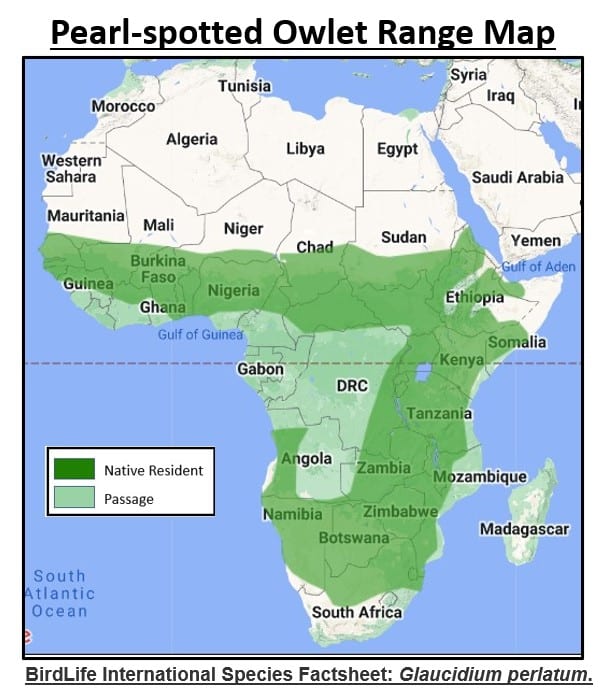2 Species of Owls Found in Guinea Bissau! (2025)
Do you want to know the different types of owls in Guinea Bissau?

If so, you have come to the right place. In the article below, I have listed the owls you can expect to see. For each species, you will find out how to identify each owl correctly, along with pictures, interesting facts, and RANGE MAPS!
The temptation to intersperse this entire article with puns is almost overwhelming. I could just wing it and beak-off about these birds all day long, but I really do give a hoot, and soon you would be talon me to stop it. Ok, settle down because that is owl you get. 🙂
2 Types of owls found in Guinea Bissau!
#1. Barn Owl
- Tyto alba

Identifying Characteristics:
- They have a heart-shaped, white facial disk with a tawny brown outline. Their eyes are black.
- The head, back, and tail are yellowish-brown with some white or ashy grey spots, and the underparts are white.
- Adults are 17.3 inches (44 cm) tall, with a wingspan of 9 to 12.6 inches (23 to 32 cm).
Although Barn Owns typically roost in hollow trees, they’re often found in caves, wells, and even secluded buildings. They’re nocturnal, so anywhere that provides a dark, quiet space for this species to rest is a likely spot for a roost.
Barn Owls eat small rodents, insects, baby rabbits, small birds, frogs, lizards, and bats. They fly low over the ground, searching out prey with their excellent night vision, and quietly grab their meal from the ground.
Interestingly, wild Barn Owls in Guinea Bissau have a fairly short life span of around two years. But, when kept in captivity, this species can live up to 20 years. Although most animals live longer in captivity due to protection from predators and steady feeding, the Barn Owl takes it to a new level!
While this species is most active at night, they occasionally hunt just after sunrise or before sunset. Instead of trying to find one by sight, listen for its noises which can be varied and distinctive. They communicate with drawn-out screeches, distinct repetitive twittering, or low croaks. The Barn owl can also hiss or rasp when surprised.

#2. Pearl-spotted Owlet
- Glaucidium perlatum

Identifying Characteristics:
- The facial disc is brown and white, with yellow eyes and a yellow beak.
- The upper body is brown with white spots and two dark spots outlined in white form false “eyes” on the back of its head.
- Adults are 6.6 to 8.3 inches (17 to 21 cm) long with a wing length of 4 to 4.7 inches (10-12 cm).
The tiny Pearl-spotted Owlet is the smallest owl in Guinea Bissau.
Even the fully-grown adults are called owlets because of how little they are!
This species is active throughout the day and at night but prefers to hunt in the dark. During the day, the Pearl-spotted Owlet roosts in small bushes and often bathes in open water. You’re likely to see one splashing around in a lake, stream, or large pond.
The Pearl-spotted Owlet usually hunts grasshoppers and crickets. However, they also hunt lizards, small rodents, bats, snakes, or other small birds if those prey species are available.
They give a loud series of short shrills that start slow and then accelerate in tempo and pitch. Towards the end of the shrill, the tempo and the pitch lower again, with the last two shrills being longer. When distressed, Pearl-spotted Owlets alert their mates through soft whistles and peeps.

Do you need more help identifying an owl you saw in Guinea Bissau?
If so, check out this field guide, which is full of great information!

View Today's Price!
And be sure to check out these other articles about animals in Guinea Bissau:
-
14 Common Birds in Guinea Bissau
-
2 Types of Snakes in Guinea Bissau
- 12 Amazing ANIMALS to see in Guinea Bissau! (ID guide w/ pics)
Which of these owls have you seen before in Guinea Bissau?
Leave a COMMENT below!



